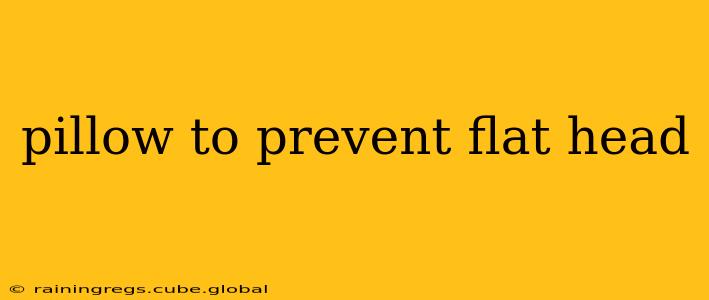Flat head syndrome, also known as positional plagiocephaly, is a condition where a baby's head becomes flattened in one area. While often mild and correctable, it's a concern for many parents. Choosing the right pillow can play a role in preventing this, but it's crucial to understand that pillows alone aren't a guaranteed solution and shouldn't replace other recommended practices.
What Causes Flat Head Syndrome?
Before we delve into pillows, let's understand the root causes of flat head syndrome. Often, it's linked to:
- Premature birth: Premature babies often spend more time lying down, increasing the risk.
- Time spent lying on their back: The "back to sleep" campaign, while crucial for preventing SIDS, can contribute to flat head syndrome if not properly managed.
- Torticollis: This condition involves neck muscle tightness, making the baby prefer turning their head to one side.
- Limited movement: Babies who are less active or spend prolonged periods in car seats or carriers are at higher risk.
What Type of Pillow is Best to Prevent a Flat Head?
The American Academy of Pediatrics (AAP) generally advises against using pillows for infants under 12 months old. However, for some babies, certain types of pillows may help reduce the pressure on the back of the head. These are not intended to be a replacement for tummy time or other preventative measures. Always consult your pediatrician before using any type of pillow for your baby.
Options that some pediatricians may suggest (always check first!):
- Positioning wedges: These gently incline the baby's head, potentially distributing pressure more evenly. The angle should be mild.
- Specialty infant pillows: Some companies manufacture pillows specifically designed to support the baby's head and neck without posing a suffocation risk. These often feature breathable materials and a contoured shape. Crucially, these should only be used under the strict guidance of your pediatrician.
What to Absolutely Avoid:
- Standard adult pillows: These are far too large and soft for infants and pose a serious suffocation risk.
- Pillows filled with loose materials: These present a choking hazard.
- Pillows that create a deep recess: The baby's face could become embedded, hindering breathing.
Does Tummy Time Help Prevent Flat Head?
Yes. Tummy time is essential. It helps strengthen neck muscles and encourages the baby to lift their head, reducing the pressure on the back of the skull. Start with short sessions (a few minutes at a time) and gradually increase the duration as your baby gets stronger. Always supervise your baby during tummy time.
How Often Should I Change My Baby's Sleeping Position?
Regularly changing your baby's position during sleep is vital. You should alternate between sleeping on their back and their sides. If your baby shows preference to one side, try gently encouraging them to turn the other way. However, this is not something to force.
When Should I Worry About Flat Head?
While many babies experience some degree of head flattening, it often resolves on its own. However, consult your pediatrician if you notice:
- Significant asymmetry in your baby's head shape.
- The flattening doesn't improve over time.
- You have concerns about your baby's head shape.
Can a Helmet Help Correct Flat Head Syndrome?
In more severe cases, a doctor might recommend a cranial helmet. This is a custom-fitted helmet that gently reshapes the skull. This is typically reserved for babies with more significant flattening that doesn't improve with other measures.
Disclaimer: This information is for educational purposes only and should not be considered medical advice. Always consult with your pediatrician or healthcare provider before making any decisions related to your baby's health and well-being. They can provide personalized guidance based on your baby's individual needs.
